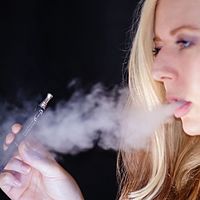
Photo from wikipedia
The popularity of disposable fourth-generation electronic cigarettes (ECs) among young adults and adolescents has been increasing since the ban on flavored cartridge EC products such as JUUL. Although the constituents… Click to show full abstract
The popularity of disposable fourth-generation electronic cigarettes (ECs) among young adults and adolescents has been increasing since the ban on flavored cartridge EC products such as JUUL. Although the constituents and toxicity of some cartridge-based fourth-generation ECs, such as JUUL, have been studied, limited data exist for other disposable ECs such as Puff. The purpose of this study was to determine flavor chemicals, synthetic coolants, and nicotine concentrations in 16 disposable Puff devices, evaluate the cytotoxicity of the different flavors from the Puff brand using in vitro assays, and investigate the health risks of synthetic coolants in EC products. Gas chromatography/mass spectrometry was used to identify and quantify chemicals in Puff EC fluids. One hundred and twenty-six flavor chemicals were identified in Puff fluids, and 16 were >1 mg/mL. WS-23 (2-isopropyl-N,2,3-trimethylbutyramide) was present in all products, and concentrations ranged from 0.8 to 45.1 mg/mL. WS-3 (N-ethyl-p-menthane-3-carboxamide) concentrations ranged from 1.5 to 16.4 mg/mL in 6/16 products. Nicotine concentrations ranged from 40.6 to 52.4 (average 44.8 mg/mL). All unvaped fluids were cytotoxic at dilutions between 0.1 and 10% in the MTT and neutral red uptake assays when tested with BEAS-2B lung epithelial cells. The cytotoxicity of Puff fluids was highly correlated with total chemical concentrations, nicotine, WS-23, both synthetic coolants, and synthetic coolants plus ethyl maltol. Lower concentrations of WS-23 than those in the fluids adversely affected cell growth and morphology. Concentrations of synthetic coolants exceeded levels used in consumer products. The margin of exposure data showed that WS-3 and WS-23 concentrations were high enough in Puff products to present a health hazard. Our study demonstrates that disposable Puff ECs have high levels of cytotoxic chemicals. The data support the regulation of flavor chemicals and synthetic coolants in ECs to limit potentially harmful health effects.
Journal Title: Chemical Research in Toxicology
Year Published: 2022
Link to full text (if available)
Share on Social Media: Sign Up to like & get
recommendations!